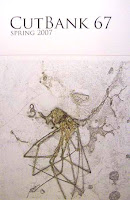
Ahsahta Press, 2006
Reviewed by Steven D. Schroeder
Credit Ed Allen for adherence to a very specific form. Each poem in his first poetry book, 67 Mixed Messages, is a sonnet. Each one addresses a character named Suzi, for whom the narrator has an illicit love. Each is an acrostic, with the first letter of each consecutive line spelling “I love Suzi Grace.” And the sestet of each begins with the phrase “I love you, Suzi.”
That Allen has produced not one but 67 functional poems out of such a stylistic straitjacket is a testament both to ingenuity and sheer hardheadedness. It also may be a project that impresses more through volume than consistent quality—the acknowledgements list a scant four of the poems as previously published in journals, and the inconsistency of the book corresponds to the snap judgment.
Allen’s narrator (a stand-in for the poet, at least in superficial biographical details) is a middle-aged professor in South Dakota who describes himself as “half gay.” Suzi is a much younger student he knows (not in the biblical sense) and pines for, both from a distance and up close, though he doesn’t explain the exact nature of their relationship.
Whatever the sexual orientation of the narrator, several of the better pieces in the collection are witty mixtures of sex and literature. One example is poem 47, “Some Linguistic Theories” (a few more than half the poems in the book have titles beyond their numbers):
In S. I. Hayakawa’s book, he states:
Language is why our mouths evolved this way.
Once I had felt how soft a wet tongue skates,
Velvet on skin—that’s not what I would say.
Some of the sonnets also successfully convey the narrator’s outward repression of his feelings (or at least their expression). From number 5, “When Did I Last Touch Suzi?”:
Each time we’ve had a drink there’s been someone
Sitting there with us, so I couldn’t speak
Until I had to make a bathroom run.
Not as effective are the poems that focus on the mundane details of the narrator’s teaching career. Three consecutive examples referencing a conference on Robert Frost come across as literary namedropping because the poems don’t make the conference in any way essential to the theme. The formal straitjacket bursts at the seams when these same poems also try to squeeze in Suzi and an unnamed friend dealing with cancer, who recurs over a longer sequence.
As the book progresses, the occasional unbecoming self-pity of the narrator and some of the attempts at humor fall flat, because both of them seem to deflect attention from the real issues (and vague creepiness) of a teacher having this sort of fixation on a student—it makes sense for the narrator to deflect, but not for the poet. It’s equivalent to telling jokes as a defense mechanism. To borrow from Ralph Wiggum: they’re funny, but they’re not “ha ha” funny.
A series of sonnets addressed to a woman invites comparisons to Shakespeare whether it wants to or not. 67 Mixed Messages definitely wants to. The back-cover copy refers to Suzi as “the dark lady,” and three of the poems are direct responses to Shakespeare sonnets. The first of these, probably best termed an affectionate restatement, begins “If Suzi’s eyes could look more like the sun,” and ends “Call me extreme, but Suzi in the sun / Exceeds all spreads that Hefner’s ever run.” Apparently airbrushing is the new “false compare.” The other responses to Shakespeare aren’t as fresh or interesting.
Anyone who has read contemporary metrical/rhyming poetry probably knows of one of its chief pitfalls: diction that avoids the contemporary in an ill-fated attempt at timelessness, instead sounding stilted or even antiquated. The best current sonneteers, from Olena Kalytiak Davis to R. S. Gwynn (the latter represented here by an enthusiastic blurb), consistently avoid such poor choices of words. Allen’s poems are also admirable in this regard. From the micro (phrases such as “fuck boots,” “Verdana Bold,” and “a riptooth of acetylene”) to the macro (poems set in college bars, cancer clinics, and a beauty pageant at a Radisson in Pierre), these sonnets are very much in the present without being confined to it.
Another problem common to many weak sonnets that does pop up here is overly rhyme/meter-driven phrasing. Is there really any reason to describe John Mellencamp as a “rich baboon” except for a rhyme with “cartoon”? Additionally, forcing the form is to blame for wrenched language such as this (Vermillion is a town in South Dakota):
Leaves give off a final heat
Of yellow-shifted sun, and nearly all
Vermillion rustles through them with their feet.
Nor would Allen, who is primarily a fiction writer with two published novels and one short story collection, be likely to put implausible dialogue like “’Under the covers, Suzi’s nice to boys, / Zero restraint’” and “’Or else I’ll have to live on Wonder Bread, / Vanilla squares, or rice and beans alone’” in the mouths of his prose characters.
Overall, a collection of this sort only goes as far as its conceit takes it, and the acrostic/”I love you, Suzi” combination doesn’t demonstrate a full book worth of staying power here. Beginning every sestet “I love you, Suzi” frequently creates problems because Allen is speaking of Suzi in the third person, throws that phrase in almost as an afterthought, and goes right back to the third person. The “Z” of the acrostic is even more problematic. It produces fun words (“Zippos,” “Zoster,” and “Zappa”) but more often results in silly choices (“Zen-like” and “Zoology-controlled”) and serious overuse (multiple instances of “Zigzagging,” “Zinc,” and “Zephyrs”).
These issues underscore my ultimate judgment of 67 Mixed Messages: though there are strong poems and good writing in evidence, the book would have been better served either with less stringent formal guidelines or with the best few poems as a short portion of a more diverse manuscript.
**
Ed Allen is the author of two novels, andwas awarded the Flannery O'Connor Award for Short Fiction for his collection Ate It Anyway. The Showtime TV version of his novel Mustang Sally (titled Easy Six) aired during the summer of 2005. A former three-day contestant on Jeopardy!, he teaches at University of South Dakota.
**
Steven D. Schroeder edits The Eleventh Muse literary journal for Poetry West and works as a Certified Professional Résumé Writer. His poetry has recently appeared in or is forthcoming from The National Poetry Review (where he won the Laureate Prize), Verse, 32 Poems, and Verse Daily. His reviews have been published by three candles and The New Hampshire Review.





